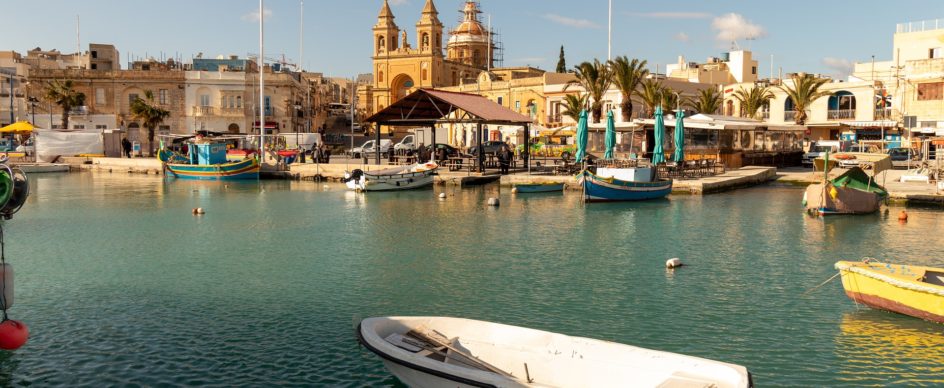
Marsaxlokk Village
- Sep 19, 2020
Is Marsaxlokk on your travel bucket list?
The Southern, small fishing village of Marsaxlokk is widely known for its picturesque sea views, vibrant boats, restaurants, Sunday fish market and Punic remains. The 4000-resident-strong village is brimming with its own micro-culture that fascinates tourists and locals alike.
Find out why you should definitely have Marsaxlokk on your travel bucket list.
Marsaxlokk’s History
Marsaxlokk history can be traced back to the Neolithic period. The north-eastern part of the village features an ancient multi-period sanctuary site known as Tas-Silġ.
Tas-Silġ features a myriad of remains from the Neolithic period, to the fourth century AD, and shows the area’s importance in the Mediterranean at large.
During the Middle ages, the area that’s now known as Marsaxlokk was a pirate hotspot, attracting corsairs from all around the Mediterranean. The frequent raids were partly due to the area’s accessible port and its connectivity with other Mediterranean ports.
Following the Great Siege of 1565, this harbour area was systematically fortified over centuries. Many of these fortifications are still standing strong to this day.
Marsaxlokk was originally part of neighbouring Żejtun, before becoming a separate village in the 1840s – when the first few fishermen made Marsaxlokk their permanent home. Its recognition as a fully-fledged village was partly due to the construction of the parish church in the 1890s.
In recent history, Marsaxlokk served as a base for the Fleet Air Arm during World War II and hosted the famous US-Soviet 1989 meeting. Nowadays, Marsaxlokk is largely considered as a modern seaside resort and a prime fishing location.
Beaches & Bays Around Marsaxlokk
While there are no beaches in Marsaxlokk, the fishing village is surrounded by some of the islands’ most-frequented beaches and bays.
Delimara’s St Peter’s Pool is a naturally-occurring pool on the outskirts of Marsaxlokk. This rocky swimming spot features crystal clear deep blue waters, making it an ideal snorkelling spot. The closest sandy beach is just 3 miles away in the neighbouring village of Birzebbuga. The small beach near Hunters’ Tower is an oft-overlooked gem that is perfect if you want to stay away from the usual swimming spots.
Marsaxlokk’s Restaurants
Marsaxlokk is a seafood lover’s culinary paradise. Most of the restaurants in Marsaxlokk specialise in freshly-caught fish and seafood, and often outdo themselves when it comes to delicious dishes.
Tartarun is one of Marsaxlokk’s top restaurants. The family-run business prides itself in serving high-quality, fish-based dishes that represent what Marsaxlokk is all about. Ta’ Victor is another excellent restaurant that specialises in traditional Maltese food: an excellent introduction to Maltese gastronomy for all those visiting the islands.
Marsaxlokk Attractions
The Sunday Market
Marsaxlokk’s Sunday market marks the culmination of the fishing village’s week. Many locals and restauranteurs frequent this market to purchase their weekly fish supplies. The market also features an exciting mixture of stalls where you can buy souvenirs, sweets, ice-cream and the trinket you never knew you needed.
St Lucian Tower
The Knights of St John constructed this watch-tower to ward off potential invaders, before eventually being rebuilt by the British in the 1870s. Nowadays, it’s administered by the Ministry of Agriculture and Fisheries and hosts the National Aquaculture Research Centre.
St Lucian Tower is open to small groups every Saturday morning.
Fort Delimara
This camouflaged fort was built by the British forces between 1876 and 1888, as part of a series of fortifications intended to protect Marsaxlokk’s natural harbour. Currently, the fort is not open to the public and can only be seen from the outside.
Tas-Silġ
This multi-period sanctuary site includes ruins dating back to the Neolithic period.
The archaeological remains prove that humans have occupied Malta for millennia. Interestingly, the hill-top site was also home to Punic, Hellenistic and Roman temples, several sculptures with Ancient Egyptian influences and a Byzantine Church, to name but a few.
Tas-Silġ is also home to a 19th-century Carmelite church that’s open daily, as well as the British era-constructed Fort Tas-Silġ.




